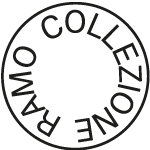Curated by Collezione Ramo
November 23 – December 1, 2024
Casa degli Artisti, Milan
For the fourth edition of Milano Drawing Week, Collezione Ramo (20th and 21st Century Italian Drawing) has produced the exhibition Carta Rampante e Attrezzo Disegnante by Manuel Scano Larrazàbal (Padua, 1981), hosting him in residence. This exhibition is part of an ongoing exploration of contemporary artists who experiment with paper and center their practice around this fragile yet powerful material.
One of the techniques used by Manuel Scano can be considered his personal take on traditional watercolor. The artist pours ink—normally used to fill markers—directly from the bottle onto the paper, then presses a second sheet against the first. The ink-soaked paper begins to dry, revealing the initial traces left by the varying amounts of liquid absorbed. As the ink dries, it creates shapes and marks, onto which new layers of water and ink are applied. After several layers of color, the artist again presses the second sheet to absorb the remaining moisture. In this way, Scano transforms the blotting action of the paper into that of a brush. This type of ink remains water-soluble, allowing the artist to both add and remove color over time through absorption and layering.
The idea of rotating this large watercolored sheet—making it rise dynamically into the surrounding space—aims to enhance its light and airy nature. At the same time, the treated sheet takes on a new materiality, arching and folding as it responds to water, air, and ink, moving away from its original appearance. The work expands into space, and by remaining suspended in motion, it invites interaction from the viewer.
In this work, the concepts of front and back do not exist. Though the artist starts on one side, the other emerges by chance. Given the paper’s considerable thickness, Scano cannot precisely predict the effect produced on the reverse side.
The element of chance is also central to the Attrezzo Disegnante (drawing tool): a kinetic installation featuring a network of fishing lines pulled by fan motors, which move markers as if they were marionettes. Wooden rods, placed between the markers and hooks, alter the immediate movement, which ultimately results in the mark left by the colored tip on the paper.
The rods also serve a sculptural function, paying homage to Calder and Miró—an affectionate tribute to these artists and a clear reference to mobiles. They cause the markers to oscillate at 360 or 180 degrees, making each movement unique and unrepeatable. To achieve this, Scano tested one marker after another, adjusting each in sequence along with the corresponding rod rotation.
Control is relinquished to the randomness with which the marker tip meets the underlying sheet, shifting angles and timing unpredictably. The artist considers his intervention complete when the marks produced by chance achieve a sufficient variety compared to his planned elements.
Throughout the exhibition, the attrezzo disegnante continues to create on the paper, changing its appearance daily until the final surprise, demonstrating how drawing today can follow singular, unexpected dynamics.












